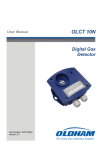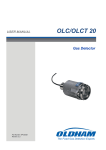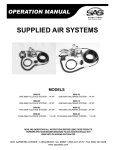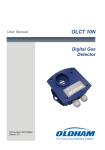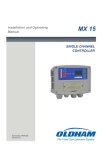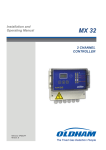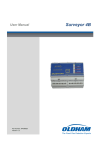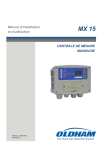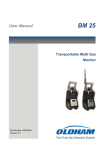Download OLDHAM OLC_OLCT 10 User Manual
Transcript
User Manual OLC 10 OLCT 10 Analog Gas Detector Part Number : NPO10GB Revision : G.1 The Fixed Gas Detection Experts 2 GAS DETECTION We are delighted that you have chosen an OLDHAM instrument and would like to thank you for your choice. We have taken all the necessary measures to ensure that your instrument provides total satisfaction. Now it is important to read this document carefully. EXTENT OF RESPONSIBILITY * OLDHAM declines its responsibility towards any person for material damage, physical injury or death resulting wholly or partly from inappropriate use, installation or storage of its equipment resulting from failure to observe instructions and warnings and/or standards and regulations in force. * OLDHAM neither supports nor authorises any company, physical or moral person to assume responsibility on behalf of OLDHAM, even if it is involved in the sale of OLDHAM products. * OLDHAM cannot be held responsible for direct or indirect damage or be required to pay direct or indirect compensation resulting from the sale or use of any of its products IF THESE PRODUCTS HAVE NOT BEEN DEFINED AND CHOSEN BY OLDHAM FOR THEIR SPECIFIC USE. CLAUSES CONCERNING PROPERTY * Drawings, plans, specifications and information included in this document contain confidential information that is the property of OLDHAM. * None of this information may be reproduced, copied, divulged or translated, by physical, electronic or any other means, nor used as the basis for the manufacture or sale of OLDHAM equipment or for any other reasons without prior consent from OLDHAM. WARNINGS * This document is not contractually binding. In the interests of its customers, OLDHAM reserves to modify the technical specifications of its equipment without notice, in order to improve its performance. * READ THIS MANUAL CAREFULLY BEFORE FIRST USE OF THE EQUIPMENT: this manual must be read by any person who is or will be responsible for using, maintaining or repairing this equipment. * This equipment will only provide the announced performance levels if it is used, maintained and repaired according to OLDHAM directives, by OLDHAM personnel or by personnel approved by OLDHAM. GUARANTEE 2 years guarantee in normal conditions of use on parts and technical labour, return in our workshops, excluding consumables (sensors, filters, etc.). 4 TABLE OF CONTENTS I. PRESENTATION OF DIFFERENT VERSIONS................................................................. 7 Different versions available .......................................................................................................... 7 II. MECHANICAL INSTALLATION OF DIFFERENT VERSIONS, DIMENSIONS AND MOUNTING ............................................................................................................................. 7 III. ELECTRICAL INSTALLATION OF DIFFERENT VERSIONS ...................................... 9 1. 2. 3. 4. IV. MAINTENANCE.................................................................................................................... 13 1. 2. 3. 4. 5. 6. V. Periodic maintenance with an OLC 10 detector (comb. gas) .............................................. 13 Periodic maintenance with an OLC 10 TWIN transmitter (comb. gas) .............................. 13 Periodic maintenance with an OLCT 10 transmitter (comb. or toxic gas) .......................... 13 Periodic maintenance with several OLCT 10 transmitters for toxic gas ............................. 15 Sensor replacement .............................................................................................................. 15 Scrapping ............................................................................................................................. 15 TECHNICAL SPECIFICATIONS ....................................................................................... 17 1. 2. 3. 4. 5. 6. VI. Connection of OLC 10, OLCT 10 EXPLO or OLCT 10 SC (Semi-Conductor) to a controller for combustible gas detection: ............................................................................... 9 Connection of two OLC 10 TWIN to a controller ............................................................... 10 Connection of two OLCT 10 TOX (maximum 5) to a controller for detection of the same toxic gas ............................................................................................................................... 11 Connection of two OLCT 10 TOX networks (5 detectors max. per network) for detection of two different toxic gases or monitoring of two conjoined areas to a two-channel controller .............................................................................................................................. 12 TECHNICAL SPECIFICATIONS - OLC 10 / OLC 10 Twin ............................................ 17 TECHNICAL SPECIFICATIONS - OLCT 10 Explo Transmitter ..................................... 18 TECHNICAL SPECIFICATIONS - OLCT 10 CO Transmitter ......................................... 19 TECHNICAL SPECIFICATIONS - OLCT 10 SC Transmitter .......................................... 20 TECHNICAL SPECIFICATIONS - OLCT 10 NO Transmitter ......................................... 21 TECHNICAL SPECIFICATIONS - OLCT 10 NO2 Transmitter ....................................... 22 DETAIL SPECIFICATIONS FOR USE IN EXPLOSIVE ATMOSPHERES IN ACCORDANCE WITH THE ATEX 94/9/CE EUROPEAN DIRECTIVE...................... 23 1. 2. Specifications for installation in ATEX Zone 2G ............................................................... 23 Metrological specifications for OLC 10 combustible gas detector ..................................... 23 2.1. Special precautions ........................................................................................................ 23 2.2. Reactions to other combustible gases ............................................................................ 23 3. MARKING .......................................................................................................................... 24 3.1. Version OLC 10 / OLC 10 Twin..................................................................................... 24 3.2. Version OLCT 10 ........................................................................................................... 24 VII. DECLARATIONS OF CONFORMITY .............................................................................. 25 6 I. PRESENT ATION OF DIFFERENT VERSIONS The OLC 10, OLC 10 TWIN and OLCT 10 EXPLO combustible gas detectors are detectors fitted with catalytic sensors and intended for use in boiler rooms and parking lots. The OLCT 10 TOX gas detectors are 4-20mA transmitters equipped with electrochemical sensors and especially designed to detect toxic gases in commercial and light industrial applications (parking lots, boiler room, etc). Different versions available - OLC 10: combustible gas OLC 10 TWIN: combustible gas OLCT 10 EXPLO: combustible gas (transmitter version, 4-20 mA output) OLCT 10 TOX: toxic gas (transmitter version, 4-20 mA output) II. MECHANICAL INSTALL ATION OF DIFFERENT VERSIONS, DIM ENSIONS AND MOUNTING 104 mm The OLC/OLCT 10 gas detectors-transmitters are mounted vertically with the cable entries positioned downwards. Drill two holes 104 mm apart on the base to mount the units. 8 III. ELECTRICAL INSTALL ATION OF DIFFERENT VERSIONS 1. Connection of OLC 10, OLCT 10 EXPLO or OLCT 10 SC (SemiConductor) to a controller for combustible gas detection: Notes: - The controller configuration will be different based upon the use of an OLC 10 or OLCT 10 - Cable to be used: 3 conductors, 3x1 mm² LiYCY type e.g., CONTROLLER MX 15 OLC 10 1 1 2 2 3 3 Connect the 3 wires based on the corresponding numbering on the controller. Connect the 3 wires based on the corresponding numbering on the sensor. 1 1= signal* 2 2= - 3 3= + OLCT 10 EXPLO *analog signal 4-20 mA (I out) on OLCT 10. Connection of two OLC 10 TWIN to a controller 2. Cable to be used: 3 and 4 core cable, 3x1 mm² and 4x1 mm² LiYCY type Connect the 3 wires based on the corresponding numbering on the controller. MX 15 CONTROLLER 1 2 3 1 2 4321 4321 3 OUT IN 4321 Connect the 4 wires based on the corresponding numbering on the previous and the following sensor. Connect the 3 wires based on the corresponding numbering on the first sensor. 1 2 3 1= signal 2= 3= + 10 OUT 4321 IN 3. Connection of two OLCT 10 TOX (maximum 5) to a controller for detection of the same toxic gas Cable to be used: One pair (0.75 mm²) screened cable Connect the 2 wires based on the corresponding numbering on the controller. CONTROLLER MX15 for example OLCT 10 TOX 1 2 3 1 3 3131 IN 3131 3131 OUT IN Connect the 2 wires based on the corresponding numbering on the first sensor. Connect the 2 wires based on the corresponding numbering on the following sensor. 1 3 1 3 Note: the free terminals 1 3 1= Iout 3= +Vdc allow the connection of another network of OLCT 10 TOX. COMMENTS: - the number of OLCT 10 toxic gas detectors shall be configured on the controller, - the signal read by the controller is the average of the “n” detectors. As a result, a signal fault may not be detected. In the event that 2 networks are used, it is cost-effective to use a single cable (2 pairs) subject to compliance with wiring as follows: 4. Connection of two OLCT 10 TOX networks (5 detectors max. per netw ork) for detection of two different toxic gases or monitoring of tw o conjoined areas to a tw o-channel controller Cable to be used: Two pairscreened cable (0.75 mm²) Example: one zone, 2 gases Detector 1 Detector 3 Detector 2 Cable with 4 wires Channel 1 Channel 2 MX 32 controller Controller with 2 channels at minimum Information for this example: - channel 1 is a channel connected to two sensors for detection of CO - channel 2 is a channel connected to two sensors for detection of NO - detector 1 (CO) also acts as junction box for detector 2 (NO) - detector 2 (NO) also acts as junction box for detector 3 (CO) - detector 3 (CO) also acts as junction box for detector 4 (NO) 12 Detector 4 IV. M AINTENANCE Caution: The actions described in this paragraph are intended for authorized and trained individuals who are likely to question the detection safety. Gas detection instruments are potential life-saving devices. Recognizing this fact, OLDHAM recommends that a functional “bump” test be performed on every fixed gas-monitoring instrument as part of a regular maintenance program. A functional test is defined as a brief exposure of the detector to a concentration of gas(es) in excess of the lowest alarm set-point for each sensor for the purpose of verifying sensor and alarm operation and is not intended to be a measure of the accuracy of the instrument. Bump test frequency depends on application, field conditions, exposure to gas, sensor technology, and environmental conditions. For new installations it may be prudent to carry out bump tests frequently at first, increasing the time intervals as confidence grows with experience in the installation concerned, on the basis of the maintenance record. The maintenance test interval should not be more than 3 months. If an instrument fails to operate properly during any functional “bump” test, a full instrument calibration should be performed successfully prior to use. Calibration frequency will be based on bump tests results. However it cannot be more than 12 months. These recommendations are based on safe work procedures, industry best practises, and regulatory standards to ensure worker safety. OLDHAM is not responsible for setting safety practices and policies. 1. - Periodic maintenance w ith an OLC 10 detector (comb. gas) The “maintenance” position was selected on the controller in order to disable its relays (see manual of relevant product) Reminder: make sure the detector is in clean air - otherwise inject zero air on the detector (with calibration kit) with a flow rate of 60 l/h, then wait for the stabilisation of measurement - Perform the zero setting of the controller (see manual of relevant product) Now inject the calibration gas (flow rate 60l/h) into the OLC 10 sensor and wait for signal stabilisation on the controller display If necessary, calibrate the sensitivity using the “S” potentiometer of the controller (see manual of relevant product) Upon completion of calibration: wait for the “return to zero” on the controller display Return to the “normal” mode of the controller (see manual of relevant product) 2. Periodic maintenance w ith an OLC 10 TWIN transmitter (comb. gas) - The procedure is almost identical to point 1 (OLC 10), with the exception of sensitivity adjustment which is performed on the OLC 10 TWIN detector that is less sensitive. - To determine the least sensitive detector, inject gas on the two detectors, one after the other (wait for the signal to read zero). The detector that gives the lowest measurement is the less sensitive. 3. Periodic maintenance with a n OLCT 10 transmitter (comb. or toxic gas) - It is required that the kit provided by OLDHAM be used (P/N 6147872) - Remove the end-cap that provides access to settings, located on the right side of the sensor - Connect this kit on the male plug of the circuit, as indicated below: ZERO (4mA) potentiometer SENSITIVITY (20mA) potentiometer CHANGER-OVER GND Voltmeter V Ref 2.5V S Signal + 4-20 mA - 4-20 mA +VDC MAINTENANCE CONNECTOR WIRES: - +VDC/red = + power supply - - 4-20 mA/blue = - of voltage, image of 4-20mA Read on the voltmeter 400mV for 4mA and 2000mV for 20mA - + 4-20 mA/green = + of voltage, image of 4-20mA - S Signal /yellow = signal from 0mV to 1600mV for zero and sensitivity setting voltmeter - Ref 2.5 V/gray = zero reference for reading of signal from 0mV to 1600mV - GND/black = electronic circuit ground. - Toggle the changer-over (under the connector) on «CAL» position (to the right) Caution: after 9 minutes the transmitter automatically returns to normal operation! (only version OLCT 10 explo) Reminder: make sure the detector is in clean air - otherwise inject zero air or nitrogen on the sensor at a flow rate of 60 l/h – and wait for the stabilisation of the measurement given by the voltmeter. - Set the ZERO using the zero potentiometer to read 0 mV on the voltmeter - Now inject the calibration gas (60l/h), wait for the signal stabilisation on the voltmeter - If required, set the sensitivity using the “S” potentiometer to read 1,600mV for the full scale (corresponding to 20mA) - Note: if you use a gas concentration lower than 100% of the scale, calculate (rule of three) and adjust to obtain the corresponding value (from 0 to 1600 mV) - Stop calibration gas injection (remove the calibration cup) - Wait for the “return to zero” on the voltmeter - Again toggle the changer-over to the normal position (to the left) 14 Notes regarding the OLCT 10 version for combustible gases: - the transmitter controls an “ambiguity resolution” function: if the sensor detects a gas concentration over 100% LEL (20 mA), it will be locked on a signal of 23.2 mA acknowledgeable through power supply shut-off or toggling of maintenance switch. The ambiguity resolution may be automatically acknowledged if the PPS3 points are short-circuited. PPS3 - Upon switching on, the output signal is set to 2mA during the 60-second stabilisation time. 4. Periodic maintenance w ith several OLCT 10 transmitters for toxic gas Use the procedure described in the previous paragraph. However: - 5. Start with the last transmitter in the loop in relation to the controller Calibrate each transmitter in the loop and end with the first Sensor replacement Sensor has to be replaced as a result of impracticable calibration or as a preventive measure. Perform a new calibration after a sensor replacement. 6. Scrapping Concerning the conservation, of the protection and the improvement of the quality of the environment, as well as for the protection of the health of the persons and the careful and rational use of natural resources, OLCT 10 has to be the object of a selective collection for the electronic equipment and cannot be scrapped with the normal domestic waste. The user thus has the obligation to separate the OLCT 10 of the other waste so as to guarantee that it is recycled in a sure way at the environmental level. For more details of the existing sites of collection, contact the local administration or the distributor of this product. 16 V. TECHNI CAL SPECIFICATIONS 1. TECHNICAL SPECIFICATIONS - OLC 10 / OLC 10 Tw in Combustible gas detector Detection principle: Catalytic Range: 0-100% LEL methane, propane or butane. Output signal: Wheatstone bridge circuit Power supply: Current through Oldham MX controllers Connections: OLC 10 Version: - 3-wire terminal block, maximum distance 300 m in 1.5 mm² with MX 15 controller - 1 cable gland M16: cable diameter 4 to 8 mm OLC 10 Twin Version (two sensors on channel input MX 15) - 1 3-wire terminal block to the controller - 1 4-wire terminal block to the second sensor - maximum total distance 300 m in 1.5 mm² with MX 15 controller - 2 cable glands M16: cable diameter 4 to 8 mm Dimensions: Material: Protection: Storage: Estimated lifetime: Temperature range: Humidity range: Pressure range: Linearity deviation: Width 118 mm, Height 157 mm, Depth 60 mm Plastic IP66 6 months safe from air 0°C<T<20°C +10%<RH<60% > 36 months -10°C to + 45°C 0% RH to 95% RH 1 bar ± 20% from 0 and 70% LEL: 1% LEL CH4 from 70 and 100% LEL: 7% LEL CH4 Long-term drift under normal operating conditions: Zero < 10% LEL/year Sensitivity < 20 % of the measured value/year Humidity impact: (10 to 90% RH) at 40°C ± 5 % of relative sensitivity Response time: T50 <10 sec, T90<20 sec Certification: Electromagnetic Compatibility EN 50270 Explosive Atmospheres: II 3 G / Ex nA IIC T6 2. TECHNICAL SPECIFICATIONS - OLCT 10 Explo Transmitter Combustible gas transmitter Detection principle: Range: Catalytic 0-100% LEL methane, propane or butane. Signal output: 4 – 20 mA, default 0.5 mA or 23.2 mA Ambiguity resolution: signal sets at 23.2 mA if measurement 100% LEL Acquit by power cycling the transmitter Ambiguity resolution may be deleted through point of programming Settings: Local through Zero and Sensitivity potentiometers Position Maintenance 2 mA 6-pin connector for gas measuring and current image (100-ohm shunt) Power supply: Consumption: Cable length: Load resistance: Connection: 15 to 30 V dc maximum 100 mA according to the controller 300 ohms 3-wire terminal block, 2 wires for power supply, 1 wire for signal 1 cable gland M16: cable diameter 4 to 8 mm Dimensions: Material: Protection: Storage: Width 118 mm, Height 157 mm, Depth 60 mm Plastic IP66 0°C<T<30°C Estimated lifetime: Temperature range: Humidity range: Pressure range: Linearity deviation: > 36 months -10 to + 4°C 0% RH to 95% RH 1 bar ± 20% from 0 and 70% LEL: 1% LEL CH4 from 70 and 100% LEL: 7% LEL CH4 Temperature drift: (-10°C + 40°C) < 5% LEL Methane or < 20% of indication Long-term drift under normal operating conditions: Zero point < 10% LEL methane Sensitivity < 20% of measured value/year Humidity impact: (10 to 90% RH) at 40°C ± 5% of relative sensitivity Response time: T50 <10 sec, T90<20 sec Certification: Electromagnetic Compatibility EN 50270 Explosive Atmospheres: 18 II 3 G / Ex nA IIC T4 3. TECHNICAL SPECIFICATIONS - OLCT 10 CO Transmitter Detection principle: Electrochemical sensor Range: 0-300 ppm CO Signal output: Settings: 4 – 20 mA Local through Zero and Sensitivity potentiometers Position Maintenance 2 mA 6-pin connector for gas measuring and current image (100-ohm shunt) Power supply: Consumption: Cable length: Connection: 15 to 30 VDC maximum 30 mA according to the controller 1 terminal block with 2 input wires, 1 terminal block with 2 output wires If cable with a gas signal pair: 1 terminal block with 2 input wires with copy on 1 terminal with 2 wires 2 cable gland M16: cable diameter 4 to 8 mm Dimensions: Material: Protection: Width 118 mm, Height 157 mm, Depth 60 mm Plastic IP66 Storage: 6 months safe from air Estimated lifetime: Temperature range: Humidity range: Pressure range: Linearity deviation: > 24 months -10 to + 45°C 15% RH to 90% RH 1 bar ± 20% 0 - 100 ppm ± 3 ppm 100 – 1,000 ppm ± 4% relative Temperature drift: (-10°C + 40°C) < 5 ppm or < 5 % of the indication 0°C<T<20°C Long-term drift under normal operating conditions: Sensitivity: < 10% of measured value/year Response time: T50 <15 sec, T90<30 sec Certification: Electromagnetic Compatibility EN 50270 Explosive Atmospheres: +10%<RH<60% II 3 G / Ex nA IIC T4 4. TECHNICAL SPECIFICATIONS - OLCT 10 SC Transmitter Detection principle: Range: Signal output: Settings: Power supply: Consumption: Cable length: Connection: Dimensions: Material: Protection: Storage: Estimated lifetime: Temperature range: Humidity range: Pressure range: Linearity deviation: Temperature drift: (-10°C + 40°C) Long-term drift under normal operating conditions: Response time: semi-conductor sensor 0-2000 ppm R134A, R22 4 – 20 mA Local through Zero and Sensitivity potentiometers Position Maintenance 2 mA 4-pin connector for gas measuring and current image (100-ohm shunt) 15 to 30 VDC maximum 100 mA according to the controller 3-wire terminal block, 2 wires for power supply, 1 wire for signal 1 cable gland M16: cable diameter 4 to 8 mm Width 118 mm, Height 157 mm, Depth 60 mm Plastic IP66 6 months safe from air 0°C<T<30°C > 24 months -10 to + 60°C 20% RH to 90% RH 1 bar ± 10% 0 - 10 ppm ± 0.3 ppm 10 – 30 ppm ± 5% relative < 0.4 ppm or < 20 % of the indication Sensitivity: < 20% of measured value/year T50< 51s (R22) T50 <30 sec, (R134a) Minimum sensitivity threshold Maximum sensitivity threshold Recommended Alarm Threshold Minimum time to detect the lowest concentration Recovery time Certification: 10 ppm 5000 ppm during 90s without sensitivity loss 200 ppm less than 25s after injection of 500 ppm R134A less than 160s after injection of 8 min of 1000 ppm R134A Electromagnetic Compatibility EN 50270 In accordance with EN 14624 certification 20 5. TECHNICAL SPECIFICATIONS - OLCT 10 NO Transmitter Detection principle: electrochemical sensor Range: 0-100 ppm NO Signal output: Settings: 4 – 20 mA local through Zero and Sensitivity potentiometers Position Maintenance 2 mA 4-pin connector for gas measuring and current image (100-ohm shunt) 15 to 30 VDC maximum 30 mA according to the controller 1 terminal block with 2 input wires, 1 terminal with 2 output wires If cable with other gas signal pair: 1 terminal block with 2 input wires with copy on 1 terminal block with 2 wires 2 cable glands M16: cable diameter 4 to 8 mm Width 118 mm, Height 157 mm, Depth 60 mm Plastic IP66 6 months safe from air 0°C<T<20°C +10%<RH<60% > 36 months -10 to + 45°C 15% RH to 90% RH 1 bar ± 20% Power supply: Consumption: Cable length: Connection: Dimensions: Material: Protection: Storage: Estimated lifetime: Temperature range: Humidity range: Pressure range: Linearity deviation: 0 - 10 ppm ± 3 ppm 10 - 100 ppm ± 5 % relative Temperature drift: (-10°C + 40°C) < 10 ppm or < 10% of the indication Long-term drift under normal operating conditions: Sensitivity: < 20% of measured value/year Response time: T90 < 120 sec Certification: Electromagnetic Compatibility EN 50270 Explosive Atmospheres: II 3 G / Ex nA IIC T4 6. TECHNICAL SPECIFICATIONS - OLCT 10 NO2 Transmitter Detection principle: electrochemical sensor Range: Signal output: Settings: 0-30 ppm NO2 4 – 20 mA local through Zero and Sensitivity potentiometers Position Maintenance 2 mA 4-pin connector for gas measuring and current image (100-ohm shunt) Power supply: Consumption: Cable length: 15 to 30 VDC 30 mA max according to the controller Connection: 1 terminal block with 2 input wires, 1 terminal block with 2 output wires If cable with other gas signal pair: 1 terminal block 2 input wires with copy on 1 terminal block with 2 wires 2 cable glands M16: cable diameter 4 to 8 mm Dimensions: Material: Protection: Storage: Estimated lifetime: Temperature range: Humidity range: Pressure range: Width 118 mm, Height 157 mm, Depth 60 mm Plastic IP66 6 months safe from air 0°C<T<20°C +10%<RH<60% > 24 months -10 to + 50°C 15% RH to 90% RH 1 bar ± 20% Linearity deviation: 0 - 10 ppm ± 0.3 ppm 10 - 30 ppm ± 5 % relative Temperature drift: (-10°C + 40°C) < 0.4 ppm or < 20% of indication Long-term drift under normal operating conditions: Sensitivity: < 20% of measured value/year Response time: T90 < 60 sec Certification: Electromagnetic Compatibility EN 50270 Explosive Atmospheres: 22 II 3 G / Ex nA IIC T4 VI. DETAIL SPECIFICATIONS FOR USE IN EXPLOSIVE ATM OSPHERES IN ACCORDANCE 94/9/CE EUROPE AN DIRECTIVE WITH THE ATEX The OLC 10 sensor complies with the requirements of the ATEX 94/9/CE European Directive regarding explosive atmospheres. The site manager where the equipment is installed should take into consideration and comply with the information in the following paragraphs. Refer to the provisions of the ATEX 1999/92/CE European Directive regarding the enhancement of safety and health of the workers exposed to explosive atmosphere risks. 1. Specifications for installation in ATEX Zone 2G The installation will be performed in accordance with existing standards, in particular EN 60079-14 and EN 60079-17 standards. The detectors are designed for surface industries Group II, Category (3) G zone 2 for minimum and maximum ambient temperatures from –25°C to + 60°C. They should not be exposed to mechanical vibrations. The detectors are installed vertically (wall-mounted type) with the cable output downwards. An angle of over 45° from the vertical or a horizontal position (ceiling-mounted type) will result in measurement errors and will require a recalibration of the detector. 2. Metrological detector specifications for OLC 10 combustible gas The OLC 10 combustible gas detector is compliant with the European standards EN 61779-1 and -4 for methane (calibration gas), butane, propane and hydrogen (gas following response curves), when they are used with SV 4B, MX 15, MX 32, MX 42A, MX 43, MX 48, MX 52 OLDHAM controllers. Note: the vibration tests based on EN 61779-4 paragraph 4.13 have not been conducted because they do not apply due to the operating conditions of this type of detector. 2.1. Special precautions Sensors are sensitive to some poisons that may cause their desensitisation: emanation of siliconized vapours with concentrations > 10 ppm, chlorinated species or sulphur with concentrations > 100 ppm The lack of oxygen (< 15% O2) or over-oxygenation (> 23% O2) may cause an underestimation or overestimation of the measurement. 2.2. Reactions to other combustible gases It is recommended to calibrate the detector with the gas to be measured. When the user wishes to calibrate it with another gas than that detected and factory programmed, refer to the table below, using the recommended gas and corresponding coefficient. Table 1: COEFFICIENTS FOR CALIBRATION Empirical Gas Vapour Coefficient Coefficient Coefficient density CH4 H2 But 8.5 % 2 1.75 1.25 1.0 4.0% 75.6% 0.069 1.25 1.0 0.8 CH4 5.0% 15.0% 0.55 1.0 0.75 0.55 C3H8 2.0% 9.5 1.6 1.5 1.1 0.85 LEL LSE C4H10 1.5% Hydrogen H2 Methane Propane formula Butane Gas recommended for the calibration. Example (first line in the table): calibration of a “Acetone” detector with a calibration gas of 1% butane volume Value to be displayed: 1% (injected butane) x 100 x 0.95 (butane/acetone coefficient) = 63% LEL 1.5% (LEL butane) Note: - 3. LEL varies based on sources. Those reported here are required by European standard EN 50054. The coefficients are accurate at 15% MARKING 3.1. Version OLC 10 / OLC 10 Twin OLDHAM Arras OLC 10 / OLC 10 TWIN II 3G Ex nA IIC T6 OSA 05ATEX0116 Caution: electrostatic loads. Rub or wipe with a damp cloth only. Serial number, year of fabrication. 3.2. Version OLCT 10 OLDHAM Arras OLCT 10 II 3G Ex nA IIC T4 OSA 05ATEX0116 Caution: electrostatic loads. Rub or wipe with a damp cloth only. Serial number, year of fabrication. 24 VII. DECLAR ATIONS OF CONFORMITY 26 The Fixed Gas Detection Experts EUROPEAN PLANT AND OFFICES Z.I. Est – rue Orfila CS 20417 – 62027 Arras Cedex FRANCE Tél: +33 (0)3 21 60 80 80 – Fax: +33 (0)3 21 60 80 00 Website: http://www.oldhamgas.com AMERICAS Tel: +1-713-559-9280 Fax: +1-281-292-2860 [email protected] ASIA PACIFIC Tel: +86-21-3127-6373 Fax: +86-21-3127-6365 [email protected] EUROPE Tel: +33-321-608-080 Fax: +33-321-608-000 [email protected]





























